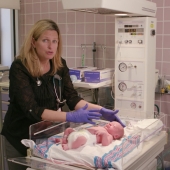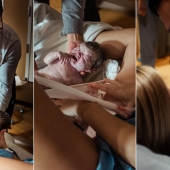Labor may be induced when the mothers or baby's conditions just that it would be safer for the baby to be born or if the pregnancy has carried on past 12 days over to you. There are a variety of methods that can be used to induce labor.
You may be offered one or all of the methods described depending on your individual circumstances. Prior to formal methods of induction you will be offered a vaginal examination and a membrane sweep at 40 and 41 weeks.
If you are having your first baby and at 41 weeks if you are having your second or subsequent baby research suggests that there is an increase in spontaneous labor within 48 hours of a membrane sweep. You will be given information by the doctor or Midwife booking the induction and you'll be told where and when to come. All inductions are carried out within the hospital setting. When you first arrive you will be shown to your bed and introduced them at birth.
Looking after you we will then assess the baby's well-being via monitoring and perform a routine antenatal examination. There will be an opportunity to ask questions prior to commencing a process. The ultimate aim of induction is to get your body into labor and there are several ways this may be done. Every woman and her baby are individual and so this process may vary slightly.
Following is the initial assessment your cervix will be assessed by the vaginal examination and the method for induction will be decided upon. Often synthetic hormones Prostaglandins will be required to begin labor. The first of these is called propess. This is a slow-release pessary which is essentially a tablet on a string. This will be inserted into your vagina for 24 hours. The job of this pessary is to soften the cervix and get it ready for labor.
Sometimes it may start off flavor depending on the reason for your induction. You may be able to go home for up to 24 hours until the next step of the induction. If you do not go into labor or your waters do not break while pessary is in. The cervix will be reassessed after 24 hours and the pessary will be removed if your cervix has changed. It is possible to break your waters you will be moved to the labor ward when it is safe to do so.
If your service has not changed enough for us to be able to break your waters then another hormone will be used to continue the induction. This hormone is called prostine and is similar to the prepess already used. This is usually in a gel form and is inserted into the vagina via an applicator. Unlike the prepess nothing remains in the vagina and the gel is absorbed the frosting worked over 6 hours and this process will be repeated after this time.
Generally there is a maximum of 3 insertions of prostine and it will be possible to break your waters or you'll go into labor at some point during this process. Throughout the whole of the induction process you and your baby will be monitored via observations and CTG monitoring of your baby's heart rate. When it has been decided that it is possible to break your waters you will be transferred to the labor ward. If the labor Ward is very busy you will sometimes need to wait on the antenatal ward until it is safe to transfer you. Your baby will continue to be monitored until it is safe to transfer you.
When you are moved to the labor ward you will be shown into a room where you will stay for the duration of your labor. You will be introduced to your Midwife and have an opportunity to ask any questions before the process continues. The Midwife will then perform another vaginal examination and carefully perform an artificial rupture of membranes.
You may then be given some time to mobilize to encourage your body to go into labor. If your labor does not naturally occur after this time, it will be recommended that a synthetic hormone called syntocinon is given by a drip to stimulate your contractions. This hormone will start at a low level and be slowly increased until your contractions are occurring for in every 10-minute period and lasting one minute. If syntocinon is used then your baby will be continuously monitored throughout the rest of your labor. This can be done via telemetry and does not mean that you have to remain on the bed. Pain relief options will be discussed throughout this process.
- 6861 views













